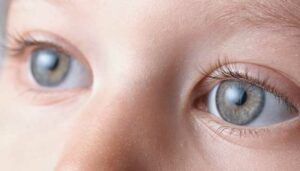Cataracts are a common eye condition that can occur in anyone, but they most often affect older adults. If you are experiencing any of the following symptoms, it is important to see an optometrist as soon as possible to determine if you have cataracts. In this blog post, we will discuss cataract symptoms, as well as ways to manage them.
Contents
9 Warning Cataract Symptoms

A cataract is a medical condition in which the lens of your eyes becomes cloudy and opaque. This can lead to a gradual decline in vision, eventually leading to blindness if left untreated. Here are 9 warning cataract symptoms to look for:
Blurred Vision
One of the earliest warning signs is blurry vision. You may find that you have difficulty seeing or reading at a distance, looking at objects up close, or dealing with glare from bright lights. This may initially be confused for nearsightedness or farsightedness, but is more likely to be a symptom of cataracts.
Double Vision
Another symptom can include double vision when looking at objects up close. This can be quite disorienting and is a sign that cataracts are affecting the way the light enters your eyes. For example, you may see two images overlapping each other when looking at text or objects.
Cloudy Vision
Some people may experience cloudy vision, which makes it difficult to enjoy activities such as outdoor sports or going to the movies. It’s like looking through a fogged-up window. In fact, cloudy vision is one of the most common symptoms of cataracts.
Diminishing Night Vision
As the cataract advances, you may find that your night vision dims significantly. This is due to the opacity of the lens, which affects how much light can enter your eyes. For instance, if you drive at night, you may experience difficulty seeing road signs or headlights from oncoming cars.
Glare Sensitivity
Those with cataracts may be more sensitive to glare from oncoming headlights or bright light sources in general. Many people may find that their eyes become strained and uncomfortable when exposed to bright light sources. This might occur regardless of the time of day.
Poor Color Perception
In some cases, cataracts can make colors appear dull or faded. You may find that you have difficulty distinguishing between certain shades of the same color. This might look similar to viewing the world through a foggy, colorless lens.
Frequent Prescription Changes
If you’ve been using corrective lenses to manage your vision and suddenly find yourself needing to switch to a stronger prescription, it could be caused by cataracts. For example, if a person who usually wears glasses for reading now finds themselves needing them to do daily tasks, such as driving.
Halos Around Lights
People with cataracts may also experience halos around lights or starbursts. This is due to refracted light that passes through the lens and affects vision clarity. Cataracts can make the vision seem distorted, making it difficult to accurately perceive your surroundings.
Reduced Peripheral Vision
Finally, you may experience a reduction in your peripheral vision. This is because the area around the cataract will become cloudy and block some of your sight. It is usually a gradual process, but it can be quite disorienting when it is finally noticed.
All in all, these are a few cataract symptoms that can be warning signs of this condition. It is important to visit your doctor if you experience any of these symptoms, as early diagnosis and treatment can help manage the condition and potentially prevent any further vision loss.
What Are The Risk Factors For Developing Cataracts?
 There are several factors that increase the risk of developing cataracts. Some of these are listed below:
There are several factors that increase the risk of developing cataracts. Some of these are listed below:
- Age: As you get older, your risk of developing cataracts increases significantly.
- Ultraviolet rays from the sun: Prolonged exposure to ultraviolet (UV) radiation is thought to increase the risk of cataracts.
- Diabetes: People with diabetes have a higher risk of developing cataracts.
- Smoking: Studies have shown that smokers are more likely to develop cataracts than non-smokers.
- Previous eye injury or surgery: Trauma to the eyes, such as from blunt trauma or surgery, can increase the risk of developing cataracts.
These risks are often difficult to control, so it’s important to be aware of the symptoms and signs of cataracts. Otherwise, it can be difficult to diagnose and treat the condition in its early stages.
What Age Do Cataracts Usually Start?
This is something that’s still under research and debate in the medical community. Some studies suggest that cataracts can start developing in people as young as 40, but most often appear after age 60. There are no definite timeframes as to when cataracts can start, so it’s important to be aware of the warning signs.
In fact, there are some different types of cataracts that can develop at early ages, such as:
- Congenital cataracts
- Traumatic cataracts
- Secondary cataracts
Therefore, the exact age at which cataracts start to set in varies. You should be aware of the signs and symptoms to look out for, regardless of your age. With the right diagnosis and treatment, you can manage your cataracts.
How Can You Manage It?
If you suspect you may have cataracts, it’s important to seek medical attention from an eye specialist. Depending on the severity of your condition, the doctor may recommend different forms of treatment to help manage the condition. A few common management strategies include:
- Wearing sunglasses or eyeglasses with special lenses that can block out UV rays and reduce glare.
- Undergoing surgery to remove the cataract and replace it with an artificial lens.
- Taking vitamins and supplements as recommended to help improve vision.
- Using eye drops or ointments to reduce inflammation, pain, and irritation.
- Consuming a healthy diet full of fruits and vegetables that contain antioxidants which can help protect the eyes from damage.
- Practicing good hygiene such as washing hands regularly, avoiding touching the eyes, and wearing protective eyewear when needed.
- Regularly seeing an ophthalmologist for checkups and to keep track of any changes in vision.
- Avoiding activities that put extra stress on the eyes such as watching TV for long periods of time, working on a computer for extended hours, or reading small print.
These are just some of the ways to help manage cataracts, but it’s important to follow the advice of your eye specialist and take any prescribed medications as directed. If left untreated, cataracts can lead to more serious vision problems such as blindness. That’s why it’s so important to be aware of the warning signs and seek treatment if necessary.
Conclusion
In conclusion, cataract symptoms are not something to be taken lightly. Early detection and management of cataracts are important for preserving eyesight, so if you believe that you may have any of the symptoms listed above, it is important to speak with your eye care professional right away.
With a comprehensive eye exam, your doctor can diagnose cataracts and provide treatment options to help you manage your symptoms and reduce the risk of vision loss.
Cataract surgery is a safe and painless procedure. At MantraCare we have a team of experienced eye surgeons, who will be happy to answer any questions on cataract surgery. Call us at +91-9711116605 for any inquiries.
